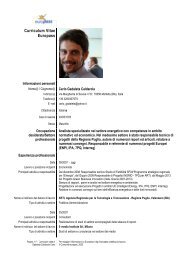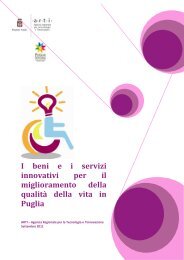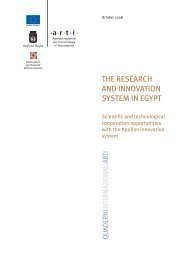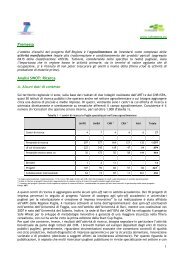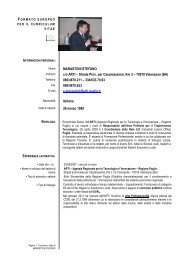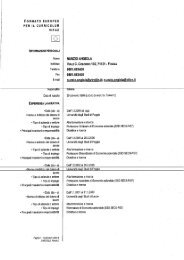ARTI Egitto definitivo - ARTI Puglia
ARTI Egitto definitivo - ARTI Puglia
ARTI Egitto definitivo - ARTI Puglia
Create successful ePaper yourself
Turn your PDF publications into a flip-book with our unique Google optimized e-Paper software.
computer centers and research institutes throughout Egypt and is the Egyptian gateway to<br />
the Internet . Internet use is available to all universities, faculty members, and graduate<br />
students (with about 1300 users in the mid-1990s). More than 80 organizations throughout<br />
Egypt can also access it.<br />
3.5. International Cooperation Projects for Basic Education<br />
Extensive foreign influence is apparent throughout Egyptian education. Examples include<br />
UNESCO and Fulbright support of overseas teacher training, World Bank engagement in<br />
distance education and educational reform as part of loan programs, and technical and<br />
scientific education aid using expertise, facilities, and equipment from Americans, French,<br />
Germans, Italians, and Japanese. UNICEF aids in development of educational materials.<br />
Teachers are sent overseas to the United States, the United Kingdom, and France for<br />
training. The Egyptian-Swiss Fund for Development works to improve primary education.<br />
Pan Arabic conferences set the aims and goals of education in Egypt and other nations.<br />
3.6. Higher Education<br />
Higher education is provided by universities and higher institutes of technical and<br />
professional training, both public and private. Responsibility for higher education lies mainly<br />
with the Ministry of Higher Education. Organization and administration, as well as academic<br />
programs, are determined by laws, decrees and government regulations. The State<br />
universities are under the authority of the Supreme Council of Universities. Universities<br />
have full academic and administrative autonomy. They also carry out scientific research.<br />
The higher institutes of professional and technical training award qualifications equivalent to<br />
the first qualification conferred by the universities. Open college education was introduced<br />
at the universities of Cairo, Alexandria and Assiut in 1991. Private universities are entitled<br />
to implement their own criteria of admission and to set fees without intervention from the<br />
Ministry. Besides, Some Egyptian universities have begun to establish certain modified<br />
curricula which can be joined by students paying their own fees. This can represent and<br />
important source of funding as most of the students are constitutionally granted free<br />
education .<br />
The higher education system in Egypt is made up of 18 public universities with more than<br />
2.4 million students, 12 public non-university institutions, and 22 private universities<br />
providing technical and professional training. Of the 12 non-university institutions, 8 are<br />
two year upper secondary-level technical institutes (MTI), and four- or five year higher<br />
education-level technical institutes. Those are joined by 115 private institutes giving the<br />
same type of education. There are more than 63.000 teaching staff in the Egyptian higher<br />
education.<br />
The first stage of higher education consists of four to six years of multidisciplinary study in<br />
basic subjects. They lead to the award of the Baccalaureate degree. In Medicine, studies<br />
last for six years, with one additional year of practical work. The best graduates are usually<br />
offered the positions of a teaching assistant.<br />
34<br />
THE RESEARCH AND INNOVATION SYSTEM IN EGYPT





